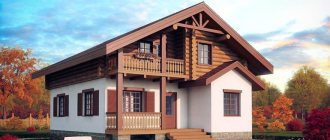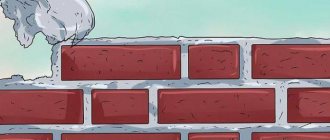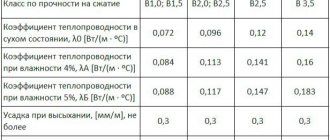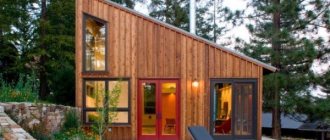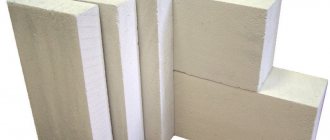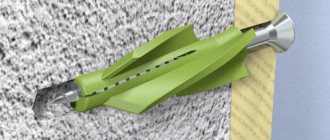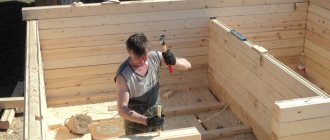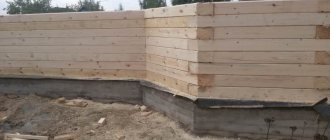The essence of construction raw materials is timber and foam block
To the ignorant layman, timber appears as ordinary wood of regular shape, made from a certain grade. And the foam block is gray autoclaved aerated concrete. This is true. But a professional always sees shortcomings in any material and knows how to solve problems associated with it.
Timber – building material No. 1:
- It has several types - from simple to glued. The cost of the latter belongs to the premium class. The unpresentability of the first requires cladding, which also affects the price.
- Insulation is required. The only exception can be combined glued options, where polystyrene foam is laid between the lamellas. Such options are cheaper than using wood alone.
- Wood tends to be subject to deterioration - rot, mold, parasites. Without using protective chemical impregnations, you can waste money.
- Self-construction requires great skill. If we consider the issue of a house made of timber or foam blocks from this point of view, then the second option undoubtedly wins.
- Valuable types of wood are expensive – that’s a fact.
When undertaking wooden construction, the owners pursue, first of all, such a goal as ecology. In this, raw materials have no equal. Next, about the disadvantages of concrete derivatives.
Characteristics of foam blocks and timber
Before we talk about what is cheaper – timber or foam block, let’s consider all the pros and cons of these building materials.
Advantages of foam blocks
A house made of foam concrete blocks is warm and comfortable
- The mass of foam blocks is small, which allows you to avoid making a powerful foundation.
- The dimensions of the foam concrete blocks are 20x30x60 centimeters, so the walls are laid out quite quickly. The installation process is simple and even an inexperienced builder can handle it.
- Foam concrete is easy to process, both for external and internal work.
- Foam concrete has a porous structure, due to which it has high noise-absorbing and heat-insulating properties.
- Foam concrete blocks do not rot and do not support combustion.
Disadvantages of foam blocks
This is also possible
- One of the disadvantages is the fragility of the material, especially during transportation. Also, during the shrinkage process, cracks may appear on the walls.
- Due to the porosity of the material, strong moisture absorption occurs. Therefore, walls made of foam concrete blocks must be additionally finished.
Types of timber used in house construction
When deciding whether to build a house from timber or foam blocks, and choosing timber, it is important to consider that several types of timber are currently used for walls.
They differ primarily in the methods of their production and, accordingly, in price.
- The cheapest and easiest to produce is ordinary, non-profiled timber. When making it, the log is simply cut off on all four sides.
- More difficult to produce and therefore more expensive is profiled timber.
- Glued material, which has been gaining popularity lately, is even more expensive.
Advantages of non-profiled timber
Easy to assemble the corners of a timber house
Comparing the material and finding out which is better - foam block or timber, we will talk specifically about non-profiled material because its price is comparable to the price of foam concrete blocks.
- This profiled timber retains natural moisture, making the manufacturing process as simple as possible and the cost is relatively low.
- It is the non-profiled material that is the most in demand in the construction of private houses and at the same time the most popular offer on the construction markets.
- Due to the fact that manufacturing is a simple process, there is no need to place an order and wait for a long time for its delivery.
- The instructions for assembling log houses are very simple and do not require the use of special construction equipment. A team of three people can cope with this task without any problems.
Attention: Proper connection of the units to each other will help to avoid issues such as heat leakage. That is, construction technology must be followed.
Disadvantages of non-profiled material
A house based on non-profiled material needs additional finishing
- Need for additional finishing or sharpening. The most effective way is to create a hinged ventilated facade on the outside, using clapboard, blockhouse or siding as cladding.
- A lot of time and money is spent on such a process as caulking. Without this work, the material quickly deteriorates and the thermal insulation qualities of the walls are lost.
- Most often, there is a difference in height between the crowns and different heights of the seams. To prevent this from happening, it is necessary to pay attention to quality, which can significantly increase its price.
- The appearance is imperfect. An unprofiled material has much worse attractiveness than, for example, a profiled one, which becomes noticeable when sharpened or sanded. The inter-crown insulation and seams begin to catch your eye.
- Possibility of fungal infection. The material has natural moisture and is not specially dried, which, if stored improperly, can lead to damage to the wood.
Outwardly, this is expressed in the fact that the tree receives a specific color. On the other hand, modern means are capable of destroying the fungus and preventing its development, but this leads to increased costs and takes some time.
- Non-profiled material cracks severely during shrinkage and drying. If additional finishing of the walls on both sides is not planned, the appearance of cracks leads to a deterioration in the appearance of the house and can cause a lot of problems for the owners.
Nuances associated with foam blocks:
- Environmental cleanliness is questionable. This applies to cellular options made in an artisanal way - cinder blocks. But factory elements also cannot provide a complete guarantee of crystal raw materials.
- It is not possible, unlike timber, to build multi-storey buildings - the foam block can withstand certain loads and does not have the elasticity of wood. In addition, freezing and interaction with precipitation contribute to its destruction.
- Requires mandatory lining. Firstly, it is not presentable, and secondly, moisture from the outside will destroy it over time.
- It is cheap, unlike wood. But the savings are mythical if the material was purchased not from a recommended manufacturer, but in a garage.
- Foam block requires reinforcement when it comes to load-bearing walls. This, in turn, will affect the cost of the rod and a special machine for gating - cutting out grooves for the inlays.
The main advantage of the described raw materials is the speed of construction, due to the size and lightness of the elements. And if we talk about a quick housewarming, then the question is better to build a house from timber or foam blocks, the answer suggests itself.
We compare and analyze which material is better: timber or foam block for a home
The very first criterion by which a buyer decides to build houses from lumber or blocks is environmental friendliness. The house must breathe and have a good climate inside. Undoubtedly, the most environmentally friendly lumber is made from solid wood. But, given that a simple planed interior is sheathed with gypsum board or gypsum fiber board, the environmental friendliness is equalized. And additional insulation of the facade using vapor barriers reduces the ability of the house to breathe. That is, when choosing lumber, it is better to build from chamber drying, and finish only with a decorative glaze coating or wax.
The blocks are also able to breathe, since the structure of the material is porous. But finishing will have to be done in any case. So, in terms of environmental friendliness, taking into account all subsequent finishing work, the materials are equivalent. Speed of construction is a controversial issue When comparing the speed of construction from bursa and block, manufacturers of the latter always point out that a house made from timber requires shrinkage, while the latter does not. But, taking into account chamber-drying and laminated timber, the shrinkage of which is minimal 1-2 cm, houses can compete. Only when choosing chamber drying, finishing is not necessary, which means the settlement will happen faster.
Speaking about the large weight of timber with a cross-section of 200x200 mm, we should not forget about the fragility of foam blocks. Yes, it’s easier to build a house with your own hands from the latest material, but how many blocks need to be ruined before the owner learns how to cut the material efficiently? And this is also time. The standard block size is 600x300x200 mm, timber for building a house is 200x200 and 4 m long. The difference in the speed of wall assembly will be minimal. Both materials are lightweight and easy to work with.
Is time the enemy or not?
Time is the enemy of wood, since without additional treatment it quickly begins to rot and become moldy. But will the owner of the house not take care of his walls? The timber is processed at the manufacturing stage, a second time before assembly and finally after. But blocks are afraid of moisture, and it’s too early to talk about durability. We can see with our own eyes timber houses that have been standing since the 50s. And proper treatment will allow them to last just as long. The same cannot be said about blocks. Only time will tell how long the material will last. The foam block also does not become stronger over the years, but is destroyed by wind and moisture. The whole truth about blocks is told in the video:
Design pros and cons
The design of houses made of timber and foam block can be interesting in both cases. But with blocks the situation is simpler, since the shape allows you to choose the most complex project. A wooden house made of timber still shrinks, so this should be taken into account when choosing a project. It is easier to finish the blocks, since the walls are smooth and ceramic tiles or decorative stone can easily be placed on the material. Timber walls are usually finished with a ventilated façade system. Another thing is that kiln-dried glued and profiled materials do not need finishing.
The main indicator of comfortable living is the heat capacity of the house
Indeed, being in a windswept and frozen house is not the best. Here, not only the quality of construction matters, but also the performance of the material itself. It is impossible to say right away that in this regard a house made of timber or foam blocks is better. It all depends on the following conditions:
- Parameters of the material itself. The winter house should not be made of wood less than 200 mm. The foam block standard is 240 mm.
But the timber is provided with insulation - styrene, fiber boards. Wood itself has undoubted potential in this regard - it is much warmer than stone. Combined timber is popular - a combination of wood and insulation, light weight coupled with ecology. The price of this raw material is lower than the glued solid version.
- Climate of the area. Nordic countries are unlikely to use foam blocks at their latitudes. Canada and Finland are famous for their timber buildings, and it's hard to argue with that.
If only because cellular concrete can be hygroscopic, that is, it accumulates moisture, and when it freezes, it expands, as is known, this will definitely cause damage and destruction. Wood is also capable of swelling, but with appropriate impregnations, this will be much less.
- Houses built according to all the rules from timber or foam blocks contain multi-pass ventilation - forced or natural. This is a necessary measure for warmth - replace damp air with dry air. Wood has this in full, but the timber requires insulation, which means its pores will be clogged.
Having tried the data on your own location, you can conclude that both materials require an individual approach. Next we talk about the economic component.
Wooden beam
Modern technologies make it possible to create rectangular elements of compact sizes from bulky logs, which to some extent simplifies the construction process. In most cases, profiled timber is used, which is given a certain shape using special equipment. Glued products deserve special attention, as they provide the opportunity to minimize wood imperfections.
Primary benefits
When developers are faced with the question of whether a house made of timber or foam block is better, it is always difficult to decide until all the details are carefully considered. The use of this material allows the construction of a whole complex of interesting structures on the site that can become a true decoration. Structures of this type do not require additional cladding, as the appearance is simply wonderful.
- The mass of the components is less than in the case of logs, which reduces the cost of the structure as a whole, and also eliminates the need for a massive foundation.
- Full automation of the production process allows for the production of components in a short time. The products are mostly standard, so all that remains is to make the corner grooves.
- Unlike concrete-based structures, such products are not limited by freeze-thaw cycles. At the same time, the environmental value of wood is truly high.
Elements made using glued technology.
Attention! When making profiled or any other timber, the structure of the growth rings is disrupted, so care should be maximum than when using solid logs.
Self-assembly
When choosing a house made of timber or foam blocks, you need to understand that all elements can have different dimensions and weight. This usually affects the labor intensity of the assembly process.
As for wooden analogues, not so long ago glued technology appeared, which makes it possible to reduce warping of the building components.
Therefore, first of all, you should consider the installation of these structures.
- Having built a reliable foundation, you need to make waterproofing between the piping and the foundation part. To do this, the surface is coated with bitumen mastic or covered with several layers of roofing felt.
- On the prepared cover there are strapping beams, which can be connected in various ways. The elements are attached to the base using metal crutches.
- A sealant is laid on top of the trim and the next row of crowns is installed, while the wooden beams are fixed temporarily so that a hole for fastening can be drilled.
- A dowel is driven into the beam, which fits one and a half crowns. Its diameter should be a couple of millimeters smaller than the diameter of the hole. At the last stage, it is recessed inside.
Laying wooden beams in the photo.
Addition! All other rows are laid according to the same principle. When choosing a foam block or laminated veneer lumber, you need to understand that wooden elements are installed several times faster.
Which house is better made of wood or foam block?
Today, the construction of private houses, country cottages and dachas is becoming increasingly popular. An open and main question, as always, remains the choice of material for construction. Of the huge number of options present on the market, today buildings made of foam block and wood have undeniable advantages over brick. What to give preference: timber or foam block?
Comparison of the characteristics of wood beams and foam concrete blocks
- The environmental friendliness of materials in our time of megacities and developed industry is very valuable. And in this case, we will undoubtedly give priority to natural wood, because it has the ability to “breathe”, that is, to allow air to pass through.
However, not every house made of wooden beams can be left without finishing (except for expensive laminated veneer lumber). After covering a wooden house with plasterboard, water- and windproof films, its ability to pass air drops sharply. And without finishing, the service life of a wooden house is reduced.
Foam blocks are made from lightweight foam concrete with a cellular structure, which creates relative air permeability. But, at the same time, it cannot be called natural and environmentally friendly. This is its minus.
The sound and heat insulation qualities of timber and foam concrete are approximately the same. Both materials have good sound insulation. But the ability of timber to retain heat directly depends on its thickness; a house with thin walls requires additional thermal insulation.
The thermal insulation qualities of foam concrete are directly proportional to the operating conditions; the high hygroscopicity of the material reduces its thermal insulation characteristics. In this case, it is difficult to give preference to any one of these materials, because both timber and foam concrete have their pros and cons.
The degree of moisture resistance and ability to withstand environmental influences is much higher for foam blocks, but this characteristic can only be attributed to solid blocks that have not expired. Over time, foam concrete material undergoes cracking and crumbling, so its ability to retain moisture decreases.
Wooden beams also do not compare favorably in this sense, since the porous structure of wood causes greater moisture absorption. Moreover, from frequent exposure to precipitation, wood can rot and develop fungus, and without additional impregnation with special means, the wood quickly fails. Therefore, we will still leave priority in moisture resistance to foam blocks.
- There is no doubt that the fire resistance of foam blocks is clearly superior to that of wooden beams. In this sense, foam concrete is completely safe, since it is not a flammable material, which cannot be said about flammable wood.
And this article talks about glue for foam blocks.
The most budget option
The main question - which is cheaper, a house made of timber or foam blocks - is decided on an individual basis. First of all, you need to decide on a number of parameters such as: volume of material for walls, finishing. If we compare the cost of the most affordable solid timber of natural moisture with the cost of foam concrete blocks, then the cost of wood per cube will be at least 2-3 times higher. On average, the price of foam concrete per cubic meter is 3,000 rubles, the price of non-profiled timber is from 9,000 rubles. per cubic meter Profiled timber is a little more expensive – from 10,000 rubles, laminated timber – from 20,000 rubles. per cubic meter It should be borne in mind that the cost of a cube is not the cost of the entire house.
A house made of foam concrete blocks is cheaper, but requires significant finishing costs. Source remontik.org
The external finish for both wood and foam concrete blocks can be the same. When using profiled or laminated timber, you can do without such finishing. The costs for interior finishing in any of the options are approximately the same. When choosing foam blocks it is: plastering, wallpapering or painting walls. Wood will need caulking and sanding.
Let's look at everything in detail at the production of the Drevograd company. Let's talk about the materials, the entire cycle of the production process, the pros and cons of the technology:
Features of construction from foam blocks
A foam block house is an excellent choice for anyone who wants to build a home quickly, cheaply and reliably - stone is stone, albeit porous. Foam block does not burn, unlike wood, and does not deform during shrinkage.
The main feature of building a house from foam blocks is the way the blocks are attached to each other. During the construction process you will not need any mortar or alignment relative to each other. The foam block is mounted on a special glue (it is applied with a notched trowel in a thin layer), so the most important is the first layer, which, after installation, is straightened under a level or laser level.
At the stage of forming the foundation of the building, it is important to make waterproofing, since the foam block itself has a cellular structure and can attract moisture. In some cases, you can even lay the foundation of a future building from foam blocks.
Comparison of a house built from timber and foam block
To make the final and correct choice, you need to review all the advantages or disadvantages of these materials. Today, houses that were built from these products have gained particular popularity. And why this happened is very easy to understand. They have low cost, but at the same time good performance. Moreover, such a house can be built with your own hands, without having any special skills in carrying out the work.
So, a house made of timber. When deciding on the cost of building a house, wood comes first. It is worth noting that modern timber is produced in various variations. The main advantages are:
- environmentally friendly material;
- complex structures can be erected;
- high strength.
The disadvantages include damage from insects, fungi, and fire hazard. Cracks may appear on low-quality material.
And now the house is made of foam blocks. Made from cellular concrete with an uneven structure. The cost of construction can depend on many aspects. During construction work, a combined block (of different sizes or densities) can be used. This may vary the price of building construction. Has a large number of advantages:
- small mass;
- resistant to rotting;
- Fire safety;
- the size of the block allows for simple and quick installation of walls;
- easy material processing.
The main disadvantage is the ability to quickly absorb water. This requires additional work on finishing the wall. The block also has insufficient strength, so damage may occur during transportation.
Foam concrete block
This material is a cellular concrete with a porous structure, which is achieved due to closed pores. It is impossible to immediately say that a house made of timber or foam block is cheaper, since everything depends on many factors. During construction work, products of various sizes and densities can be used, and this in any case will affect the cost of the finished structure.
Basic advantages
Although it is difficult to understand without taking into account all the circumstances which house is cheaper from timber or foam block, it is possible to classify these buildings as economically profitable. The final price may be lower if elements of optimal density and size were selected during construction. However, a cube of material based on cellular concrete is in any case cheaper than the same volume of wood.
- The thermal conductivity of the foam block is relatively low, so when using foam concrete blocks there is no need to provide additional thermal insulation.
- In terms of heat retention inside the building and soundproofing properties, the material is not inferior to wood.
- Products are able to withstand high and low temperatures, and they can easily be subjected to any processing method (sawing, drilling, etc.).
- It is possible to combine it with other building materials (brick, tiles, etc.).
- The environmental friendliness of the products has been proven, so there is no need to worry about health problems.
- Due to the large volumes of components, the construction of foam block structures proceeds quite quickly.
Note! When laying it yourself, it is advisable not to use a sand-cement composition, otherwise the cost of the building will increase, the external appearance will deteriorate, and the thermal insulation properties will also decrease.
Carrying out work
Modern houses made of foam blocks and timber are built relatively quickly, but in the case of the first structures, the construction speed is somewhat slower than with wooden analogues.
In addition, there are significant restrictions on the creation of buildings in winter. As for timber structures, they are allowed to be made in the cold season without any conditions.
- It is advisable to prepare the solution mechanically, adding the mixture gradually into containers with warm water until a homogeneous mass is formed.
- The junctions and corners are leveled, as well as the installation of beacon blocks, after which the cord is pulled at the level of the upper part. To eliminate sagging, intermediate components are installed.
- Along the axis of the side plane, door and window openings, junctions and intersections are marked. For convenient work, elements from the pallet are laid out along the wall.
- The first row is being laid. The complexity of further work will depend on its quality of execution. After installing the initial blocks, dirt particles are removed from the surface.
- Next, the well-mixed mixture is distributed evenly over the surface of the laid elements using a toothed comb. The thickness of the seam should be 3-5 mm .
- The laying of each row is accompanied by a thorough check for deviation. To control the laying of corners, it is recommended to use a wooden corner. Horizontal level is determined by the usual building level.
Addition! Thus, when deciding for yourself whether a foam block or timber is better, you should compare the installation process. You will have to choose not only a cheaper, but also a more convenient option for work.
What's better
Again, there is no specific answer to the question: “what is cheaper, timber or foam blocks?” - does not exist. But if we judge objectively and are based only on the advantages and disadvantages of materials, then the foam block is in the lead by a significant margin. Therefore, it is not surprising that it is widely used in construction and is still preferred to the same wood. However, all of the above characteristics are valid only in the case of ideal installation, storage and operation conditions, which are extremely rarely achievable. Otherwise, the characteristics of both materials become on the same level, and here it’s up to you to choose which one is better, depending on your tastes.
If you want to save money and build a house that will last for centuries, choose a foam block and do not skimp on its additional cladding and finishing. But it’s up to you to decide whether timber or foam block is better for your home.
